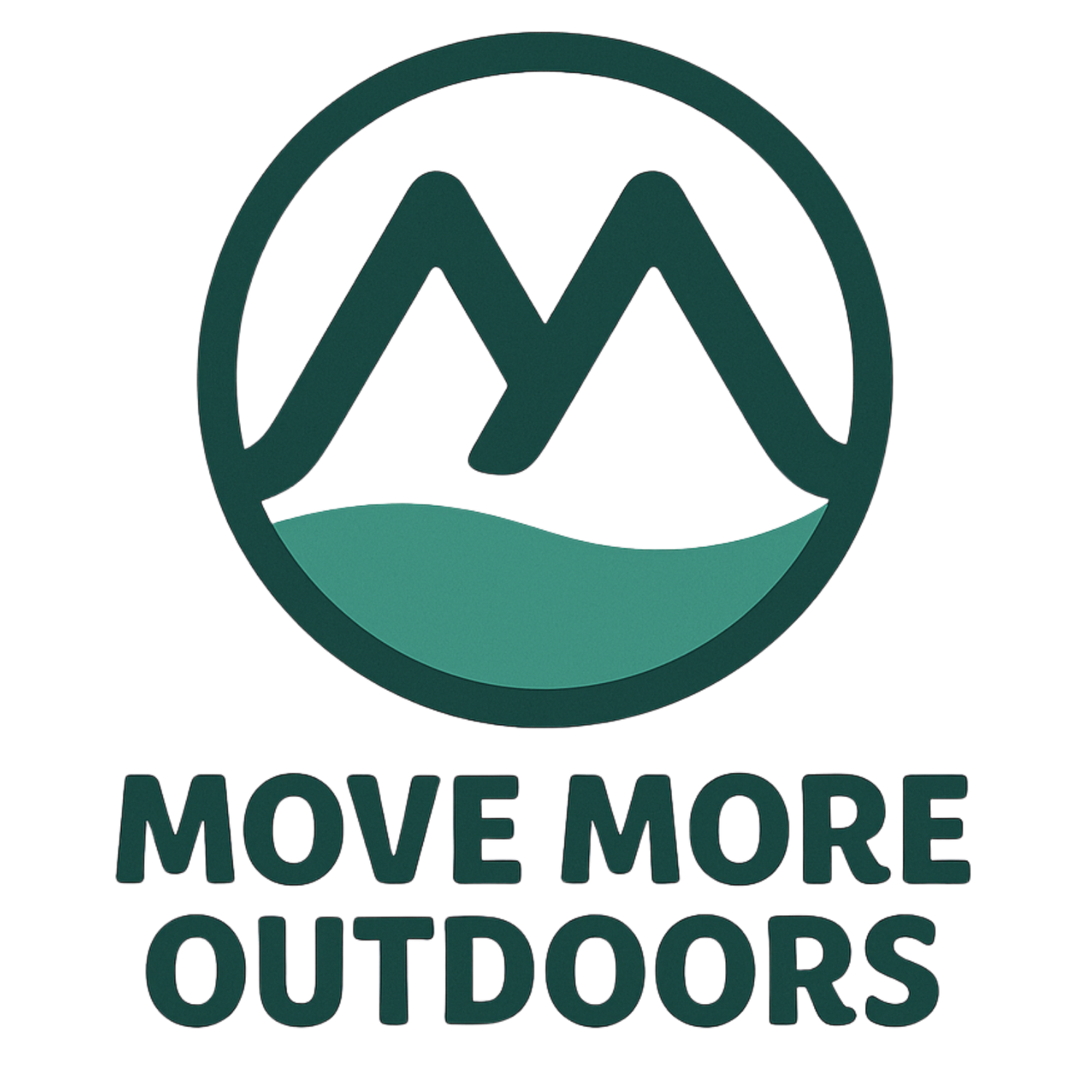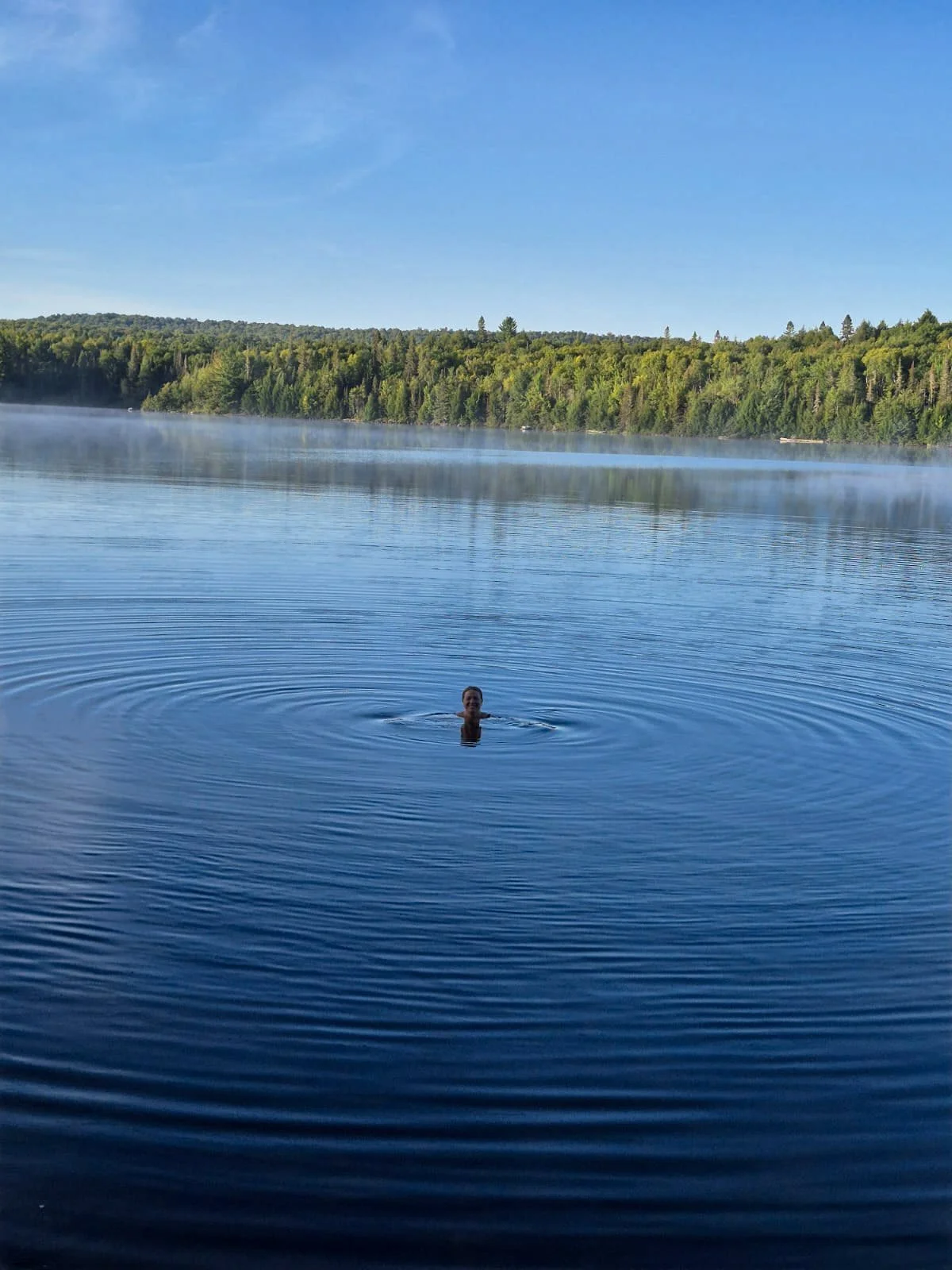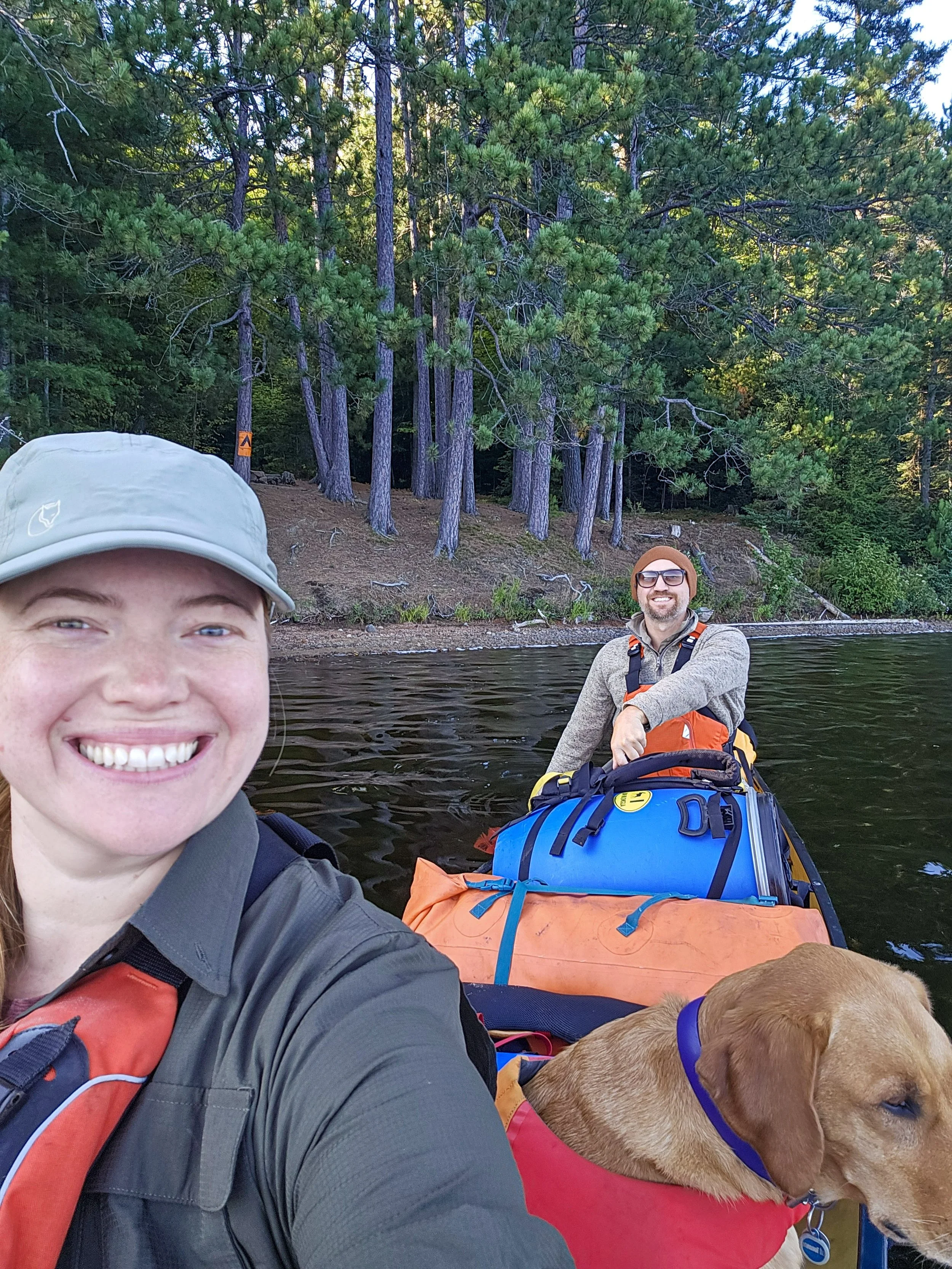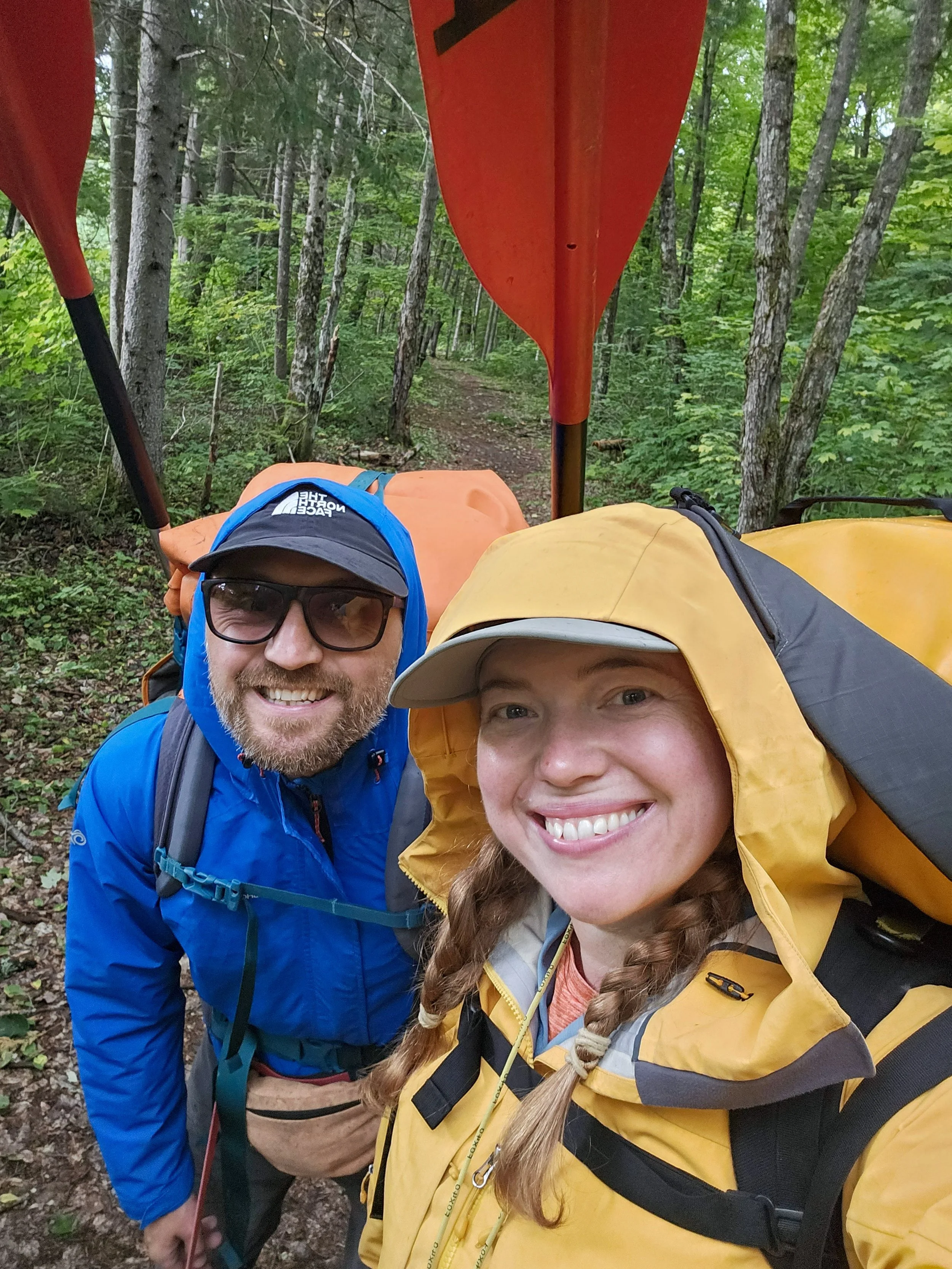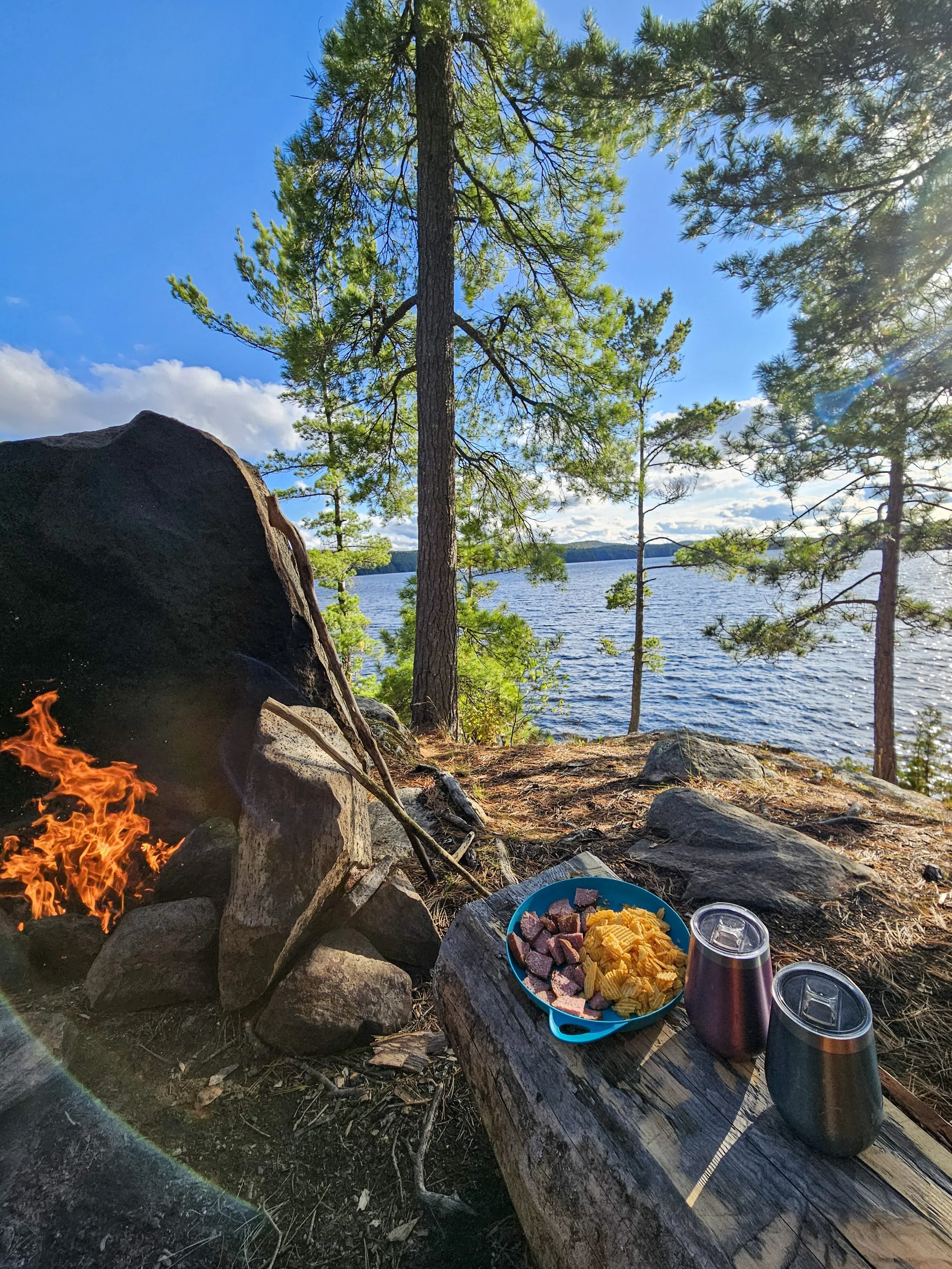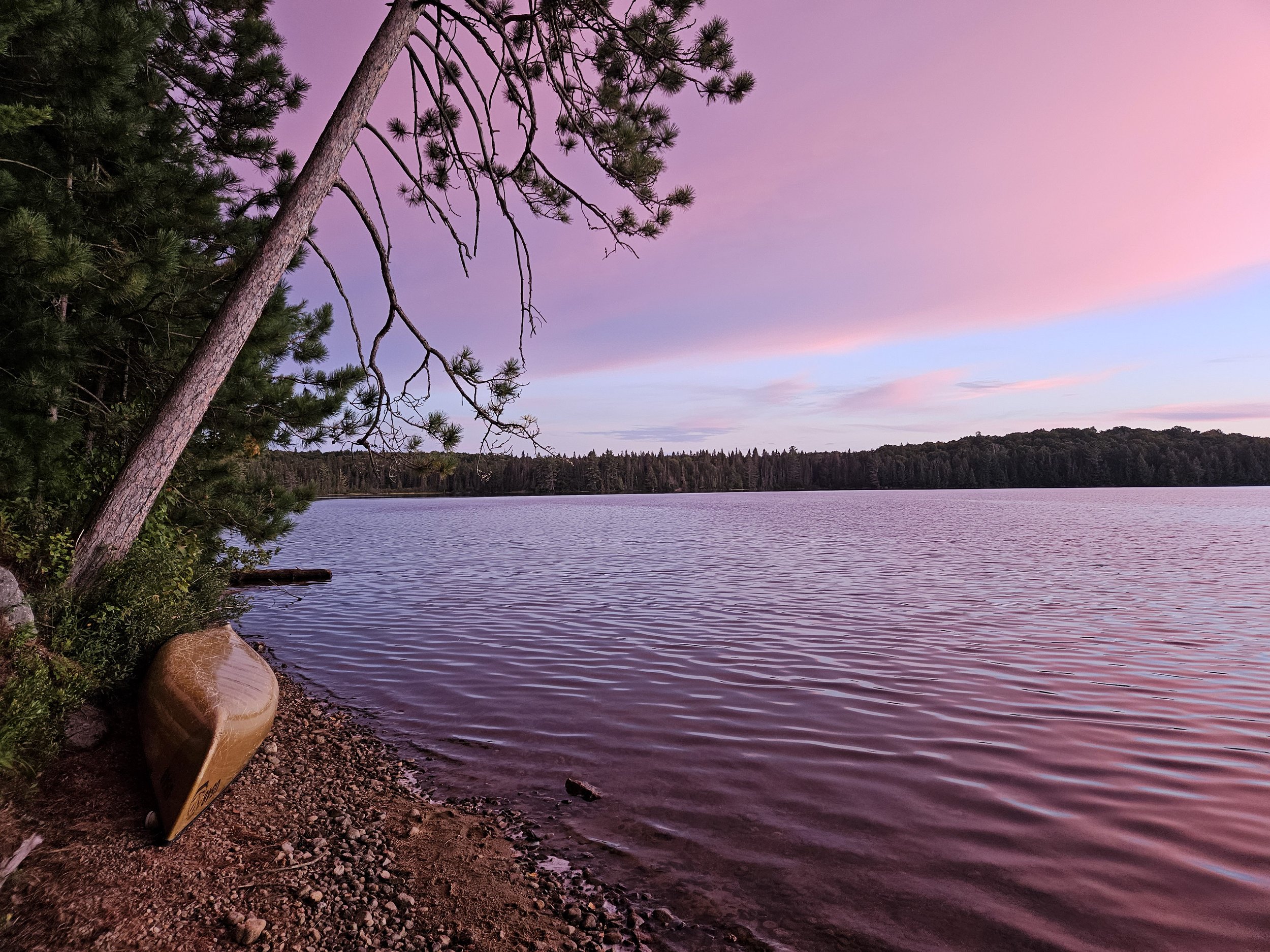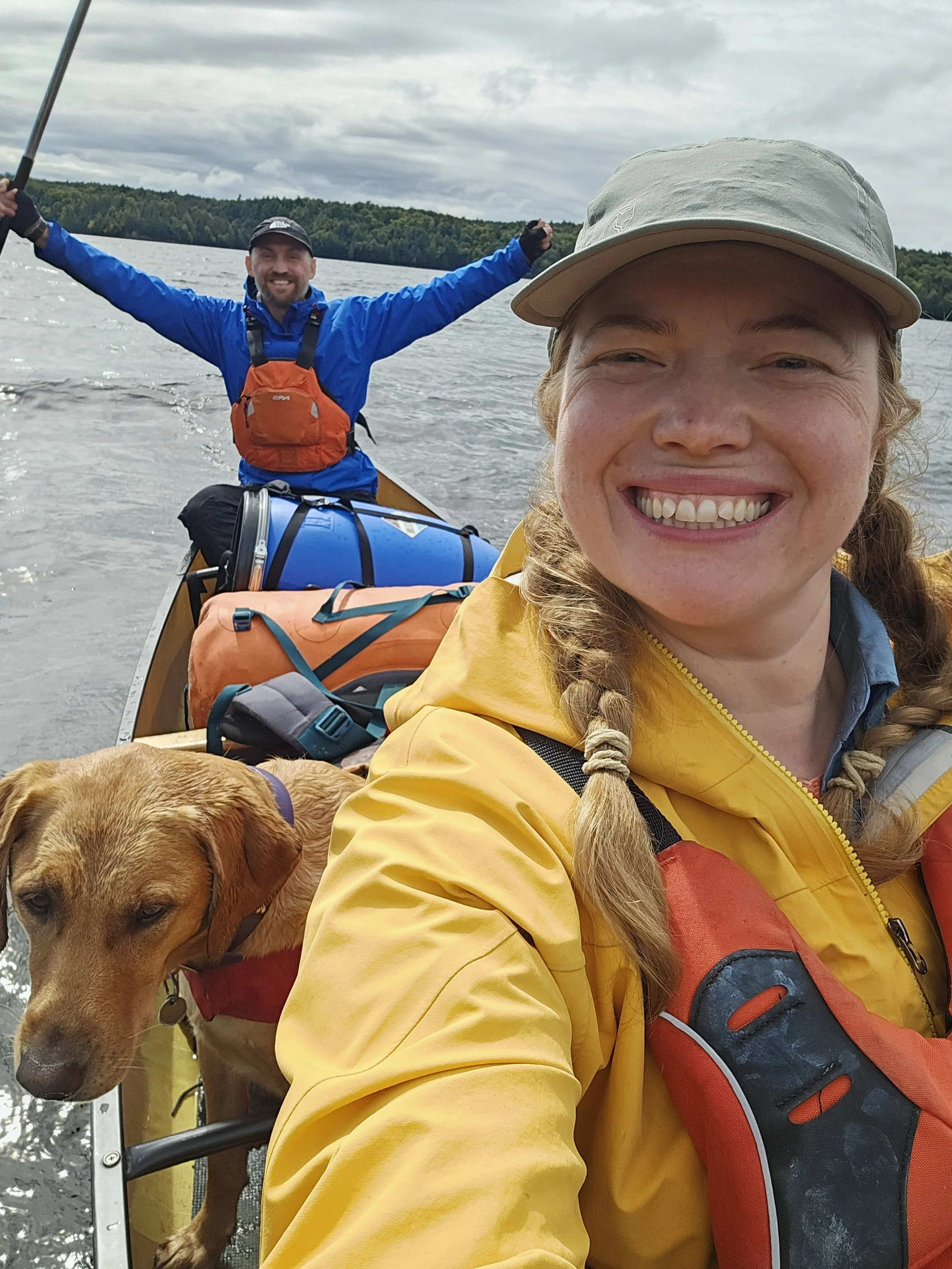Eight Days in the Ontario Backcountry
It’s taken me a while to get round to writing this up properly, but as we get prepped for our final canoe trip of the year over the Canadian Thanksgiving long weekend, now feels like the perfect time to reminisce about our eight day trip in September.
Have you ever wondered what an eight day canoe trip in the Ontario backcountry is really like? What it’s like not showering for eight days, pooping in the woods, or worrying that every tiny sound you hear in the night is a giant bear coming to make you its midnight snack? Well, that’s all part of it. But it’s also about so much more. That first sip of negroni by the campfire after a long day, the stillness of sunrise when the fog rolls across the lake, or that refreshing plunge into the water washing away the sweat and grime after a day of portaging in 30°C heat.
Enjoying a negroni on Erables Lake on day 3, Algonquin Park, September 2025
I love every minute of it, or at least that’s how it feels when you’re watching the sunset by the fire after a dip in a pristine lake. The moments where you’re dripping in sweat, knee deep in mud with a canoe over your head on a portage, or battling a headwind that makes you feel like you’re paddling backwards, are all quickly forgotten once you’ve got that negroni in hand and you’re munching on a slice of summer sausage or a Cheez-It at ‘aperitivo hour’.
Just writing this takes me back to my happy place, but how does an eight day trip come together?
Planning and Prep
Planning for a trip like this usually starts about five months before, when the backcountry campsites open for booking. I tend to do most of the planning, it’s one of my favourite parts of the whole experience. I’ll pore over maps, both the official Ontario Parks maps and Jeff’s maps, read trip reports and blogs about different routes, and then start piecing together an itinerary that I think will work for us.
For this trip we wanted to explore the northern part of Algonquin, coming in through the Kiosk access point, which was new to us. I knew the route would overlap a couple of the lakes we’d paddled before when we came in from Kawawaymog Lake onto North Tea Lake and Biggar Lake, but most of it was completely new. When I first planned it, I thought it would be a nice mix of challenge and relaxation, with plenty of portaging at the start and some easier days towards the end.
Before the trip I contacted Algonquin North Wilderness Outfitter, where we rented our canoe, to see what they thought of the route. Nelson was incredibly helpful and suggested the best way around to do the loop. His advice meant we’d finish on Manitou Lake, which has some beautiful sandy beach sites that would make for the perfect end to the trip.
All the food and cooking gear for an eight day canoe trip, can’t wait until we get a dehydrator and can cut this down! September 2025
As the summer went on, we mostly forgot the finer details of the route, and I’m not sure I ever properly talked Jake through it until about a week before we left. We convinced ourselves it was going to be an easy, leisurely paddle with lots of downtime. In the end, we paddled around 80km and portaged 37km, and it was amazing. It was also the quietest part of Algonquin we’ve ever visited, and for a couple of days in the middle we didn’t see another person, which was absolute bliss.
In the week or two before the trip we planned out all our meals, and I spent time researching the campsites on each lake we’d be staying at. In Algonquin you don’t book a specific site, you book a lake, or a zone of a larger lake, and the sites are first come, first served. I like to have a few options in mind, the better sites, the ones to avoid, and a few backups, especially around long weekends like Labour Day. After a long day of paddling, the last thing you want is to spend another hour searching for a spot.
A few years ago, some close friends of ours from the UK who came to visit bought us a pair of binoculars, and without a doubt it’s been the best gift we’ve ever received! Not only are they helpful for spotting wildlife, they’re so handy for seeing whether a site is taken in the distance without having to paddle all the way over. I use a few websites to research campsites and routes, but my favourite by far is Algonquin & Beyond. It’s such a great collection of campsite reports and is really easy to navigate. Some reports are free and others are behind a paywall, but it’s worth supporting because it’s genuinely so helpful when planning.
Morning campfire on Erables Lake, Algonquin Park, September 2025
What a Typical Day Looks Like
A typical day on a canoe trip starts around 6:00am, when Tess crawls into one of our sleeping bags for half an hour of cuddles before waking us up properly around 6:30am. One of us gets up with her and goes to fetch the food barrel, which we move away from camp overnight to keep animals at bay.
We used to hang the barrel, but finding the right kind of branch was always a nightmare. It needs to be strong enough to hold the weight but far enough from the trunk that a bear can’t just climb up and grab it (ideally 10-15ft off the ground and 4-5ft from the tree trunk). We’ve given up on that now. Instead, we securely strap the barrel to a tree, pile rocks on top, and hang bear bells from it so if anything tries to get in, we’ll hear it and can scare it off. I know plenty of people wouldn’t agree with this method, but so far it’s worked for us, so we’re sticking with it for now. If we were in Western Canada dealing with Grizzlies, that would be a different story!
The one who grabs the barrel feeds Tess and gets the coffee on. I’ve been off caffeine for a few years but still love the ritual of a morning coffee, especially in the backcountry. My favourite is Muskoka Roastery Lumberjack Decaf, it’s genuinely the best decaf I’ve found, and I love that it’s local.
While one of us handles breakfast prep, the other starts packing down the tent and sleeping gear. It usually takes a couple of hours to break camp, depending on how leisurely we’re feeling. If it’s a cooler morning we’ll often get a small fire going to warm up after our swim. Morning swims are one of my favourite parts of any trip, the water’s calm and the world feels completely still.
Morning swim on day 2 on Whitebirch Lake, Algonquin, September 2025
For breakfasts we rotate between three favourites:
Bacon and egg burritos with powdered eggs, precooked bacon, and chopped veggies.
Blueberry pancakes with bacon and maple syrup.
Instant oats with dried fruit and nuts for the days we need to get onto the water quickly.
Once breakfast is done, one of us tackles the washing up while the other finishes taking down camp. After dousing the fire and one last trip to the thunderbox (where you do your business), we pack the canoe and set off for the day. Before leaving, we always check the site to make sure we’ve left it as we found it, or better, with some wood gathered ready for the next campers. Good campsite etiquette in the backcountry is to always leave enough wood for the next people to start a fire so if the weather is bad and they get caught out or they are in an emergency they can easily get a fire going.
Toasting breakfast burritos over the fire, Algonquin Park, September 2025
Out on the Water
We take turns paddling in the bow (the front) and the stern (the back). On calm lakes, all the steering comes from the stern, so the bow paddler mainly provides power and enjoys the view.
The first few days of this trip were perfect, warm, sunny, and barely any wind. The last few days were a different story. By day seven, strong headwinds on Manitou Lake kept us from reaching the beach sites we’d hoped for. We’d originally planned day eight as a rest day before paddling out on day nine, but with the weather turning into sideways rain and thunder, we decided to make camp on a nearby island for the night and head home on day 8. Definitely the right call.
Setting off from Three Mile Lake on Day 5, Algonquin, September 2025
Portaging
Over the years we’ve built a good routine for portaging. We usually split our gear into three loads:
The canoe and the yellow day pack
The food barrel
The orange canoe pack with all our camping gear
We then shuttle the gear along the portage. For example, on a one kilometre portage, Jake takes the canoe and day pack while I take the canoe pack. Halfway along I drop the pack and go back for the barrel while Jake carries on to the end, then returns for what I’ve left halfway. It means we both walk about two kilometres in total instead of three, and it saves our backs.
Tess with the packed up gear (minus the canoe) on the morning of day 1 before loading up the car, Toronto, September 2025
On this trip we decided to also bring our small food barrel in addition to the main barrel which threw a spanner in the works. We could blame it on Tess’s food, but really it was all the fresh food and campfire cocktails! The first couple of days were tough, shorter portages but double carries meant we retraced a lot of ground. On day one alone, we did a 640 metre and a 1,200 metre portage, totalling 5.5 kilometres with all the back and forth.
By day three, after eating two days’ worth of fresh food, we managed to condense things so Jake could carry the canoe with the small barrel and I could tackle the big barrel with the day pack on top, so that we were back to our usual 3 loads. We weren’t in a rush, and taking it slow at the start was worth it.
Days three, four, and five were our biggest effort days, with around six and a half kilometres of portaging each day plus decent stretches of paddling, usually six to seven hours of activity in total. We’d usually stop halfway through the day for lunch, simple but classic… pepperettes or jerky, cheese, crackers, carrots or sugar snap peas, and a couple of snack bars. Some days we mixed it up with peanut butter and jam wraps, which turned out to be a hit.
Smiling despite the rain on our final portage to Kiosk on day 8, Algonquin Park, September 2025
Setting Up Camp
Once we arrive at the lake for the night, we usually paddle around to check a few sites before picking one. When we’ve chosen, we divide and conquer, one of us sets up the tent and sleeping gear while the other does a wood hunt. If it’s raining, the tarp goes up first and we do the rest of the tasks together for speed. Shelter and fire are always the top priorities.
After that, it’s time for a swim and a much deserved aperitif. Our go to camp cocktails are either negronis or boulevardiers which is basically a negroni made with bourbon instead of gin. They taste even better outdoors, especially with a slice of dehydrated orange for a touch of class.
Aperitif time on North Tea Lake on Day 6, Algonquin Park, September 2025
For dinners we like to have fresh food for as long as possible. On this trip we had burgers and corn with shishito peppers on the first night, steaks on the second, veggie and chorizo pasta for a couple of nights, lentil curry for another two, and then finished with freeze dried meals on the last night. Next year we’ve agreed to get a dehydrator so that we massively reduce the weight that we carry while still being able to cook tasty home-cooked meals instead of packet meals.
After dinner we sit by the fire with another cocktail, reminiscing about the day and setting the world to rights. We were pretty exhausted on this trip after long days of paddling and portaging, so we were usually tucked up in bed by about ten. Before bed we fully douse the fire and move the food barrel away from camp, ready to collect again in the morning when it all starts over.
Eight days in the backcountry always resets me. I love the simplicity, the rhythm, and the way you end up somewhere new each day. My favourite campsites were on Erables Lake and Three Mile Lake, maybe because we didn’t see another soul on those lakes so they felt extra special. It’s not that we’re antisocial, it's just nice to feel like you’re alone in the wilderness, just you and the beautiful nature around you. Unfortunately, we didn’t see any moose on this trip, it seems like you never do when you’re actually looking for them. I’m excited to keep exploring more of Ontario’s backcountry, but Algonquin will always hold a special place in my heart. It’s where I first fell in love with canoe tripping, and every time I go back, I find something new to love about this beautiful place.
Spectacular sunset on Three Mile Lake, I’ve never seen the sky so purple before, Algonquin Park, September 2025
This weekend we’re off to Killarney Provincial Park for the long weekend to wrap up our canoe season. I’m excited about going, but also a little sad that the season is coming to an end. It truly is my favourite outdoor pastime. Now I just need to find a new winter activity to keep me going in Ontario until the ice melts in the spring and we can get back out on the water. Here’s to more adventures to come!
Follow along on Instagram for more: @movemoreoutdoors
Arriving back at Kiosk Access Point after eight wonderful days in the Ontario backcountry, Algonquin Park, September2025
